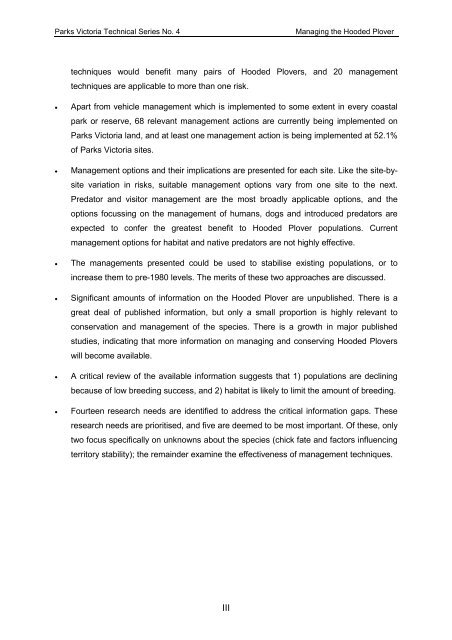Managing the Hooded Plover - Parks Victoria
Managing the Hooded Plover - Parks Victoria
Managing the Hooded Plover - Parks Victoria
You also want an ePaper? Increase the reach of your titles
YUMPU automatically turns print PDFs into web optimized ePapers that Google loves.
<strong>Parks</strong> <strong>Victoria</strong> Technical Series No. 4<br />
<strong>Managing</strong> <strong>the</strong> <strong>Hooded</strong> <strong>Plover</strong><br />
techniques would benefit many pairs of <strong>Hooded</strong> <strong>Plover</strong>s, and 20 management<br />
techniques are applicable to more than one risk.<br />
• Apart from vehicle management which is implemented to some extent in every coastal<br />
park or reserve, 68 relevant management actions are currently being implemented on<br />
<strong>Parks</strong> <strong>Victoria</strong> land, and at least one management action is being implemented at 52.1%<br />
of <strong>Parks</strong> <strong>Victoria</strong> sites.<br />
• Management options and <strong>the</strong>ir implications are presented for each site. Like <strong>the</strong> site-bysite<br />
variation in risks, suitable management options vary from one site to <strong>the</strong> next.<br />
Predator and visitor management are <strong>the</strong> most broadly applicable options, and <strong>the</strong><br />
options focussing on <strong>the</strong> management of humans, dogs and introduced predators are<br />
expected to confer <strong>the</strong> greatest benefit to <strong>Hooded</strong> <strong>Plover</strong> populations. Current<br />
management options for habitat and native predators are not highly effective.<br />
• The managements presented could be used to stabilise existing populations, or to<br />
increase <strong>the</strong>m to pre-1980 levels. The merits of <strong>the</strong>se two approaches are discussed.<br />
• Significant amounts of information on <strong>the</strong> <strong>Hooded</strong> <strong>Plover</strong> are unpublished. There is a<br />
great deal of published information, but only a small proportion is highly relevant to<br />
conservation and management of <strong>the</strong> species. There is a growth in major published<br />
studies, indicating that more information on managing and conserving <strong>Hooded</strong> <strong>Plover</strong>s<br />
will become available.<br />
• A critical review of <strong>the</strong> available information suggests that 1) populations are declining<br />
because of low breeding success, and 2) habitat is likely to limit <strong>the</strong> amount of breeding.<br />
• Fourteen research needs are identified to address <strong>the</strong> critical information gaps. These<br />
research needs are prioritised, and five are deemed to be most important. Of <strong>the</strong>se, only<br />
two focus specifically on unknowns about <strong>the</strong> species (chick fate and factors influencing<br />
territory stability); <strong>the</strong> remainder examine <strong>the</strong> effectiveness of management techniques.<br />
III

















